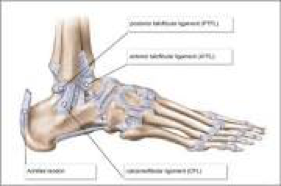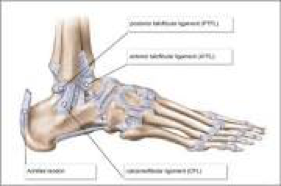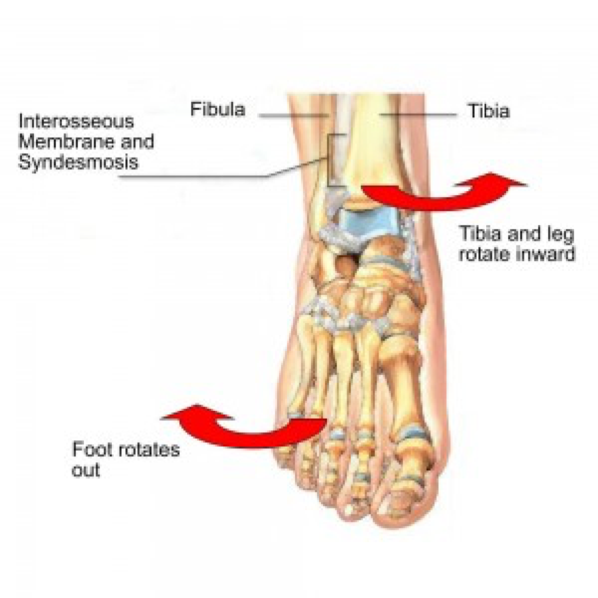Ankle sprains and strains
Ligaments help to provide stability to the ankle by attaching bone to bone and are the most commonly injured area of the ankle. There are generally 3 common types of ligament injuries around the ankle; lateral, medial and high ankle ligament sprains:
1. Lateral
The outside or lateral ligament complex is made up of 3 ligaments and is the most commonly injured ligament around the ankle. Severity depends on the degree of damage to the ligament and how many of the ligaments are affected by the injury. An injury like this could occur if you landed on uneven ground and rolled over on the outside of your ankle. This is termed an inversion injury.

2. Medial
The inside ligament is known either as the medial ligament or the deltoid ligament. Compared with the lateral ligament, the medial ligament is comprised of only one thicker ligament shaped a little like a fan. It is not as common as the lateral ligament injury but still occurs in a high number of sports when the foot is weight bearing and there is a rapid change in direction such as netball, basketball and football. In technical terms it is called an eversion (twisting outwards of the ankle) during weight bearing injury.

3. High Ankle
High ankle ligament strain is not nearly as common as your typical ankle sprain but still occurs relatively frequently and requires early detection as they are managed differently to your normal ankle sprain injury. This ligamentous area is located above the ankle between the two lower leg bones (tibia and fibula). Injury most commonly happens when the foot is planted on the ground and then an outward twisting motion of the foot occurs.

Treatment of ankle injuries
Management of ankle injuries varies depending on the severity of damage to the ligaments. It can be anything from a mild sprain of the ligament complex to tearing the ligament itself, causing instability around the ankle.
Following an ankle sprain injury there is often a high risk of repeat injury if the ligaments and other structures around the ankle have not been rehabilitated appropriately. This is because the balance mechanisms around the ankle become disrupted, which can limit the movement, strength and stability of the ankle.
Ankle rehabilitation requires restoring ankle movement, improving strength around the soft tissues of the ankle as well as focusing on balance retraining and sport specific exercises if necessary.
It is important to see your physiotherapist as soon as possible to get the right advice on initial injury management, guidance on activity levels and to help determine the best course of treatment.
For many people running is a relatively time efficient and low cost form of exercise. You can grab your running shoes and pretty much head out the door. It continues to gain in popularity with the growth of trail running, fun runs, half and full marathons targeted for all ages and abilities. These events are often family orientated and are a good way to set a fitness goal to work towards.
The journey along the way unfortunately can be a little up and down for both new and long-time runners because of the occurrence of injuries. There are a multitude of injuries that can occur with running and there are many risk factors for the development of injuries.
When you think about running, the average person per minute will land on the ground somewhere between 160-180 times (counting both feet). This is called your running cadence and if you add that up over a 60 minute run, that’s a considerable amount of times that you land on the ground. There’s also the increase in force through your body which is far greater than what occurs with walking.
Running technique
If you’ve taken some time to observe people out running, you’ll see that there’s a huge variation in running technique. It feels like you should just be able to go out and run with giving much thought to what you are actually doing, BUT there is more to it than that, especially when it comes to preventing or decreasing the chance of injury. From a biomechanical perspective, about 90% of the running population don’t know how to run or are not functionally strong enough to do it.
Obviously there are several factors which influence our running technique. There are the differences between male and female skeletal structures, which means that females generally have quite different running and landing styles to their male counterparts. Our genetic make-up has an influence on our ability to run because of the structure of our muscles, tendons, ligaments and fascia and how these combine to produce functional movement patterns. Males are generally more likely to injure their muscles and tendons with running, because they are generally able to produce more force and power.
Our postures, muscle imbalances, weakness and flexibility all influence how we run and transfer force. Working on improving your posture, muscle balance and flexibility can really help to improve your running technique and at the same time reduce the risk of injuries.
Injury history is something to consider. If you have had previous injuries from other sports or activities, then this could also impact how much you can run as well as how your body moves during the running motion.
Foot-wear
Foot-wear is another major factor. There have been and will continue to be many changes to running shoes from a more minimalist approach including barefoot running to the normal running shoe. Comfort is a huge indicator of how your shoe will perform and also influence the risk of developing injury. If the shoe feels good, then for the most part it is likely to be the shoe for you.
Training intensity
Training load is often where people tend to get into trouble. More often than not, people do too much too soon. There is a golden rule in the running community about using the 10% rule: not to increase your running time more than 10% per week. This allows for your joints, muscles and other soft tissues to adjust to the load that is being placed on them. Some people may take the approach of walk/run/walk run progression with short intervals of running, while others may start with 15 minutes running and gradually build up from there. Just remember to be kind to your body and the tissues supporting it!
There’s also your running history to consider. If you have run previously, then your body is more likely to adapt more quickly than someone who is run training for the first time.
The terrain you choose to run on can also be a factor in injury prevention. Soft surfaces such as grass and off-road trails compared with running on concrete. Flat routes compared with hilly or undulating circuits also place different strains on your body.
Running efficiency
Tips from Jason McClaren (isport biomechanics)
1) Reduce fatigue – the longer your feet remain on the ground during running the faster you fatigue
2) Speed of stride – increasing turnover of your legs will reduce the amount of time spent on the ground
3) Arm swing is important
4) Landing with your foot as close as possible beneath your body will enhance efficiency
As you can see there are many factors and influences that impact your running. It’s helpful to keep a diary of your running frequency and time, that way you can keep track of increases in load or changes to terrain and environment etc and monitor your response.
At Ponsonby Physiotherapy we can help you get the most out of your running programme; starting with identifying and correcting muscle imbalances, as well as providing useful tips on basic running technique and training load, so you can get maximum enjoyment from your running.
Call us to book a consultation.
Many people suffer from lower back pain at some point during their lives; whether it’s due to injury, incorrect lifting technique or poor posture.
Both pilates and acupuncture have been shown to deliver significant benefits in the treatment and prevention of ongoing lower back pain.
The APPI (Australian Physiotherapy and Pilates Institute) pilates method was designed by physiotherapists specifically for use in rehabilitation. The principles are based on spinal stabilisation and lumbo-pelvic stability. Pilates is about increasing your body awareness so you can identify when you’re holding your spine in a position that might put extra load and stress through the joints, ligaments and surrounding muscles. It then focuses on re-educating and training deep spinal and pelvic stability muscles to increase their strength to support your spine in an optimal position. Important principles of pilates include postural centering, control and isolation of movement, breathing, ribcage, shoulder blade and head and neck placement. The end goal is to transfer this progressive strength and muscle memory change to improve overall function and reduce pain.
Current research shows that the body awareness, movement control, postural education and breathing, which is taught in pilates, has a significant effect on decreasing pain levels in patients with lower back pain, as well as an increase in physical function and peoples’ psychological perception of their health. Our clinical experience in teaching pilates definitely supports this view. As patients’ become stronger through spinal and pelvic stabiliser activation, pain levels definitely decrease and their ability to return to normal function and achieve their sporting goals increases.
In conjunction with pilates training, acupuncture and dry needling techniques are very effective at reducing pain in lower back injuries, osteoarthritic shoulders and knees, tennis elbow and achilles injuries. Western acupuncture is used by physiotherapists to deliver pain relief via the stimulation of the nervous system to produce endorphins – the body’s own pain relieving neuro-chemicals, melatonin to promote sleep and serotonin to promote well-being.
Dry needling techniques, which focus on releasing tender knots (trigger points) within muscles, use a short in and out technique with the needle. Dry needling can be extremely useful in decreasing muscle tightness and increasing muscle length through the neck and upper back regions, the hip and lateral thigh and calf regions, which all contribute toward reducing discomfort in the lower back region.
If you are suffering from pain or discomfort in your lower back; make an appointment to see us today.
So, you have injured your hamstring and are unable to play sport or even stand on the start line of the event you have been training for. What do you need to do to help repair the damaged muscle and tendon and how do you prevent it from happening again? One of the most common mechanisms of hamstring injuries occurs from dancing and kicking activities, which tend to injure the upper tendon close to your sit bone.
You may have watched some of the Olympic hurdle events and seen an athlete pull up short gripping the back of their thigh. Sprinting and running activities is the other common mechanism which more often than not causes injury to the muscle belly itself as well as the muscular tendon.
Historically, hamstring injuries have been managed with stretching and strengthening of the hamstring muscle group itself with perhaps minimal focus on the ankle, knee, hip, pelvis and trunk regions. Because the tendon and muscle complex must heal, it has been advised that pure static stretching could be detrimental to the repair process and may in fact be a factor in recurrence rate of injuries.
Because the hamstring works across the hip and knee joint, it has to be able to work in a concentric (shortening) and eccentric (lengthening) manner to produce functional movement such as bending the knee and extending the hip. For this reason rehabilitation must include both concentric and eccentric strengthening exercises.
Rehabilitation can’t just be about the hamstring, it needs to look at the whole kinetic chain which means looking at not only the hamstring muscle region but including strengthening and agility work around the ankle, knee, hip, pelvis and trunk. It is important for the trunk to be stable to enable us to move our limbs to perform activities that we love to do, whether it is climbing, sprinting, playing soccer or just getting fit at the gym.
The rehabilitation process from hamstring injury is progressive following different phases as the tissue heals.
Phase one is all about helping to promote the healing process and developing a mobile healing tissue in a pain free motion. Typically activities in this phase start simple trunk stability work which can include such exercises as side bridges, prone and supine bridging, aerobic exercise usually in the form of an exercise bike, some agility work such as walking grapevine, fast feet and side stepping.
Phase two has a focus on promoting painfree strength, restoring the proper length of the muscle and neural tension while continuing on with trunk and pelvic control. Usually at this stage, running can be introduced as long as it is painfree. The exercises in this phase tend to increase in intensity.
The final Phase three is further advancing exercises and making them more sport or activity specific. So, if your goal was to get back to playing soccer then this stage would involve lots of change in direction, accelerating, decelerating and kicking activities as well as continuing on with trunk stabilising exercises, eccentric loading on the hamstring and balance type exercises.
The windmill exercise is one such example of an eccentrically loaded hamstring exercise which also combines trunk control and is usually introduced in phase two and further progressed in phase three. Come in and visit us for a demo.



